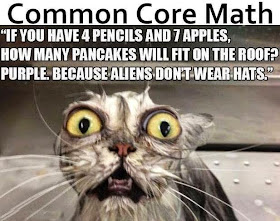In this final post on the Five Practices, we look at the final Practice - Connecting. Previous posts from this series explore preservice elementary teachers work on Anticipating, Monitoring, Selecting, and Sequencing related to this lesson from Context for Learning Mathematics (CFLM - Fosnot et. al.). Because elementary children are in short supply at our university, the future educators use professional development materials gathered from a third-grade classroom working on the turkey-cost problem as a substitute.
 |
| Image used with permission of authors New Perspectives on Learning |
In this part of the exploration, my teachers watch video of the third-grade teacher wrapping up the lesson. They look for evidence of the teacher Connecting (1) the various approaches used by the students, (2) key mathematical ideas, and (3) a new, related problem. Connections between the students' approaches are especially strong given choices she made in Selecting and Sequencing the work to share.
The transition to the next problem also seems well-thought-out as students determine how long to cook the 24-pound turkey if the cookbook suggest 15 minutes per pound.
 |
| Image used with permission of authors New Perspectives on Learning |
The connection to the turkey-cost problem is obvious to the teachers.
The part of the Connecting sequence that seems most lacking is Connecting the students' work to key mathematical ideas. I try to make it clear that it is unfair to criticize the teacher because we do not know what happened before or after the lesson or, for that matter, other contextual factors that might have influenced her instructional decision making. However, to ensure that the teachers recognize the big ideas associated with the different approaches, I offer the following additions to the lesson.
The first three students are applying the Distributive property to the cost per pound decomposed into it's whole number and decimal parts. In order to compute 24x0.25, the students are essentially factoring 24 into 6x4 (4 being the multiplicative inverse of a quarter, 0.25) and then using the Associative property to regroup the order of multiplication. Consequently, the original expression, 24x1.25, simplifies to 24+6 or $30 - the answer to the turkey-cost problem.
The last pair of students used a more efficient approach that bypassed the need for the Distributive property. They still factored 24 into 6x4, but then they used the Associative property to multiply 4x1.25 first, to get 5, and then 6x5. Again, the answer is $30.
While some of the teachers think the key mathematical ideas presented in these series of expressions might be beyond the third-graders' current understanding, the Associative and Distributive properties are found in the Grade 3 Common Core State Standards (3.OA.B.5).
What do you think? Is this too much to expect of third-graders? Do you have another way that these key ideas might be connected to the students' work?





































